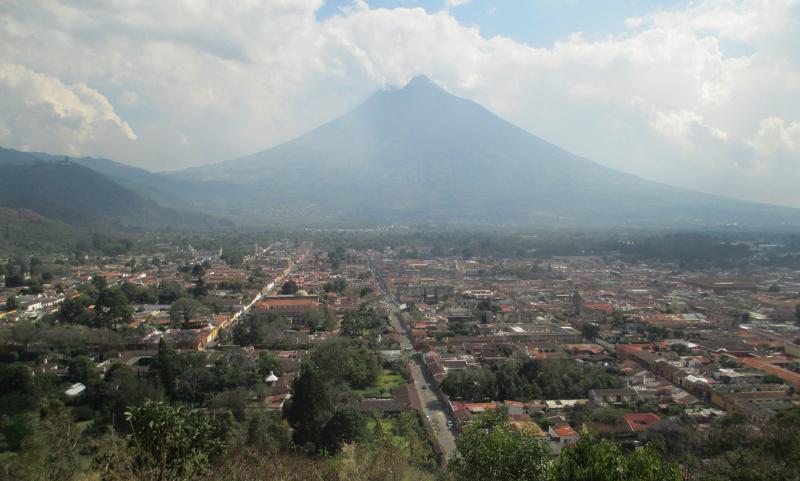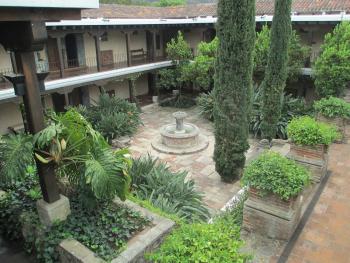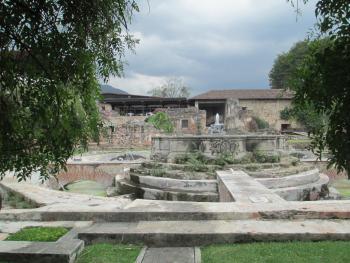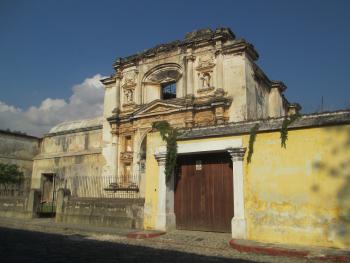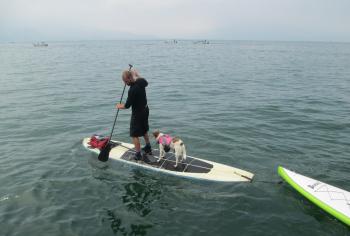A leisurely look at Guatemala’s La Antigua and Lake Atitlán
This article appears on page 30 of the March 2017 issue.
My significant other and I traveled to Guatemala in February and March 2016 and found a vast, lovely land of volcanoes, rivers, waterfalls, archaeological sites, ecological parks and nature reserves. Because we sought a restful vacation, we selected two special destinations for our stay: the former colonial capital, La Antigua, and Lake Atitlán, surrounded by small towns, villages and volcanoes.
La Antigua
Our approach to La Antigua came after an early-morning $10 van ride from the airport in Guatemala City. The van was easily located — in front of the terminal in a designated van pickup area — for our 90-minute ride.
Upon arrival, we immediately took to the favorable climate of La Antigua. Two volcanoes, one of which rumbles and occasionally puffs, overlook this former capital, providing protection from hurricanes but not from earthquakes, as indicated by the ruins that could be seen every few blocks. Still, it is a city that vibrates with pride and energy.
Workers groomed cobblestone streets with clippers under a favorable sun, and a woman in a T-shirt marked “Nuestra Antigua Limpia” (“Our Clean Antigua”) maneuvered a pair of tongs to clear the stones of litter.
Nesting in a 17th-century monastery, La Antigua’s premier accommodation, Hotel Casa Santo Domingo (3a Calle Oriente No. 28A; www.casasantodomingo.com.gt), aroused our senses with its blend of stone and wood. We decided to check in for a week.
Heavenly accommodations
Religious and colonial artifacts lined the hotel’s flowered corridors and courtyards, and 10 parrots, allowed to live out their days in the gardens, sunned themselves in the partially shaded ferns found throughout the property.
The hotel has 130 guest rooms, and ours was relaxing and elegant, furnished with art and a small, private balcony and offering a host of cable networks in English and Spanish. The darkness of some of the public spaces added to the mystique of its divine past. Flickering candles and the sound of singing choirs that floated from speakers hidden in the ferns brought sanctity to our evening strolls.
The service was attentive, and English was widely spoken.
The open-air on-site church — sufficiently restored ruins that reflect the integrity of the original structure — has become a legendary wedding venue. The hotel boasts 50 weddings a year, booked, I was told, two years out.
Coffee and tea are put out for hotel guests in the afternoon, and free local papers are available in English and Spanish. There is also a large, gated pool and a spa and massage area.
At $200 per day, including the daily Internet fee, we felt it was worth every cent.
What to see and do
Visitors from outside the hotel are welcome to browse the ruins, museums and artful reconstruction behind the hotel. Pathways pass striking ruins and detailed signage connecting museums, a candle shop and a chocolate shop, and the remains of two monks lie behind glass in an ancient crypt. A printed map informs visitors and guides them through the property.
The on-site Colonial Museum features crowns, chalices, sculptures, painted metals and religious paintings from the 16th to 19th centuries, and the Archeology Museum showcases ceramic and stone figures, vases, plates, urns and jugs.
Additional galleries exhibit pre-Columbian art and modern glass. An art hall hosts current artists during the 30 to 40 private art shows that occur each year. Five to 10 public tours are offered monthly.
Just a few doors down from the hotel is the travel agency of longtime resident Elizabeth Bell (5a Avenida Norte No. 4; antiguatours.net), who arrived from California in the late 1960s.
A local expert and the author of numerous articles and books on the area, Bell provides tours, including the basic walking tour we took for $25. Starting in the town square, Parque Central, we visited ruins, a jade factory and important landmarks in the downtown area.
Bell provided a 3-hour presentation on area history and culture, with plenty of opportunities to ask questions. She is very involved in efforts to protect and preserve local sites and freely shares insights and opinions on current events and improvement initiatives.
Throughout the tour, we enjoyed talking with other travelers as well as with volunteers who had come from the States to teach English or otherwise participate in community projects.
Bell’s office offered free magazines, including Revue, Guatemala’s English-language magazine, and Qué Pasa, which lists a schedule of community activities, including yoga (in English). I found myself stopping in to talk with her during my stay when I had questions or wanted advice.
Exploring on foot
Sidewalks in La Antigua were walkable, though narrow in places. Keeping an eye out for curbs required vigilance, also required in order to avoid bumping into the overhanging 8-inch window ledges of wood or concrete.
Street names and numbers can be hard to negotiate. However, residents are always polite when giving directions to harried pedestrians. Night walking should be done with caution, as we spotted one open manhole.
Every morning and afternoon, we walked through La Antigua exploring churches, hotels and neighborhoods.
We sought out businesses that catered to tourists before striking out on backpacking or bicycle trips. For active visitors, Old Town Outfitters (Avenida Sur 12-C) offered adventure sports gear and guidance for mountain biking, rock climbing, kayaking, trekking and the like.
Our stay overlapped with Semana Santa, a Christian holiday celebrated several weeks before Easter. A day-long parade engaged the entire population for weeks in advance as people decorated the streets with flowers.
When the day came at last, a religious parade started its journey across town. We attended the festivities late in the day, joining the crowd lining the streets in anticipation of the parade. There were entire families participating in the parade, and we felt very safe. However, we did leave our valuables (purse, camera and wallet) in the hotel after receiving stern warnings from Elizabeth Bell and others.
Notable sites
Following are three “must sees” for any visitor to La Antigua.
Parque Central is the place to go to get a feel for the community. We visited daily. Benches there provided places for relaxation, people-viewing or a shoeshine from a young boy (who we wished had been in school).
Indigenous people circled visitors, offering flutes, necklaces and scarves for sale, and uniformed schoolgirls with backpacks linked arms and squealed when spotting their friends.
Cerro de la Cruz, or Hill of the Cross, at the edge of town was a doable walk from the city center and an easy climb up paved steps for anyone with walking shoes. The ascent provided a panoramic view of the surrounding terrain, including coffee plantations. Benches allowed us to sit and enjoy the vista, punctuated by a volcano in the distance.
My final find, Jade Maya (Calle Oriente No. 34), was one of several jewelry shops in La Antigua that celebrated this precious stone. Tours were available and showrooms, with presentations and signage on the history of discovery and mining, were interesting to browse. Some good buys were available.
Eating out
While we used a travel guide to locate many good restaurants, we also found some on our own.
At Fusion Restaurant & Bar (4 Calle Oriente No. 5), we enjoyed a healthy portion of fettuccine in olive oil, with a little jalapeño added for flair. The café caramel flan was also tasty. (Our meal, including wine, cost around $20.)
Café Condesa (5a Avenida Norte; www.cafecondesa.com.gt), across from the Parque Central, served a roasted-eggplant sandwich (GTQ44, or $6) and a side salad of cucumber, onion, bell pepper and tomato (GTQ26) in a lively atmosphere filled with locals and Americans. Indoor and outdoor seating was available. We also enjoyed an appetizer of roasted red peppers, marinated with olive oil, vinegar and garlic, served with toast (GTQ36).
At Epicure (3a Av. Norte No. 11B; epicure.com.gt), the polenta gnocchi with olive oil, garlic, basil and walnuts (GTQ93) was tasty. The server also brought samples of gazpacho and a truffle for dessert.
On to Lake Atitlán
After a week in La Antigua, we were ready to move on to Lake Atitlán, which attracts many travelers, including young Americans and Europeans. We booked a shuttle transfer (less than $30 per person) for the 3½-hour trip, arranging for a safe daytime arrival. (Ask at your hotel for assistance in booking.)
The ride was pleasant, though comfort clearly depended on which seat was selected in the van, so it was important to be one of the first passengers to board.
To get the seat of our choice (I'd recommend one in the row behind the driver), we arrived with our luggage at the point of departure rather than waiting to be picked up at our hotel. Soon, the van filled with young backpackers from Europe and Australia chatting about their escapades.
Once on our way, we became only mildly impatient when a street demonstration about 90 minutes outside of town blocked all traffic in both directions for an hour. However, the delay seemed to be of no concern to our driver, who got out of the van, purchased a snack wrapped in a tortilla and stood talking with his fellow van drivers.
Back on the road, we enjoyed the mountainous views, the occasional hairpin turns and the eventual descent into the Lake Atitlán area.
Lake views
Arriving at Lake Atitlán, the van made various stops to allow travelers to disembark. Shortly, we reached San Pedro La Laguna, where we planned to spend the next several days. We chose this town because we liked the fact that our travel guides described it as authentic but sufficiently visited by tourists.
Inhabiting the town was a sizeable indigenous population whose native language was filled with soft “sh” sounds, as in a whisper. The narrow streets were shared by pedestrians, tuk-tuks and motorcycles. Still, I felt very safe in this bustling community.
The view of the lake with its surrounding volcanoes was breathtaking. The view changed throughout the day as clouds moved in around the volcanoes, cooking fires inched up the slopes and mist crept over the water.
Ferry service to the other communities around the lake is extensive, convenient and worth considering, even if only for an afternoon outing.
When we checked into Hotel Mikaso (phone +502 7721 8232, mikasohotel.com), which we had read about in a travel book, we encountered a much smaller room and bathroom than we had enjoyed at Hotel Casa Santo Domingo. Still, the Mikaso offered a friendly presence, and the staff spoke adequate English. The Internet connection was spotty, however.
After one night in a small room with an even tinier bathroom, we changed to larger accommodations ($40 per night).
We enjoyed the lake view from the hotel’s rooftop, where we read in the sun, sipped refreshments and ate good, reasonably priced snacks and meals from the restaurant located just steps away.
Daily we ventured through town, enjoying the view of the lake, appreciating the narrow vias originally designed for pedestrians and greeting the people we passed.
We ferried to a couple other Lake Atitlán communities, and the quick walks through these towns satisfied our need for exploration.
Panajachel
From San Pedro La Laguna, we ferried to Panajachel, a sizeable town that buzzed with traffic and travelers. The main shopping strip was within walking distance of the dock, and up and down that street we walked, enjoying the crafts and the occasional music. We felt no need to venture outside the area.
We stayed at two hotels in Panajachel, both a walkable distance from the dock. Hotel Jardines del Lago ($86 per night) offered beautiful gardens, lakeside views, adequate rooms with nice touches and TV reception in English. The flowered trellises, abundant roses, birds-of-paradise and bottlebrush shrubs under palm and coconut trees were lovely.
The breakfast buffet, served in a covered tent overlooking Lake Atitlán, included boiled plantains, pancakes, chocolate crêpes, granola, papaya, tamales, frijoles, omelets and great guacamole.
The disadvantage of staying at this hotel was that business travelers, tour groups and wedding parties seemed to be the desired clientele, so staff, while polite, did not seem especially motivated to engage us.
Also, the hotel had a largely open-air, as opposed to closed-corridor, layout, so conversations by passing guests could be easily heard.
At Casa Colonial PanaSurf ($64 per night), the owners, a married American couple who also runs a paddleboard business, were very friendly and personal. The hotel offered good Internet service, a good location and two friendly dogs, including one that paddleboarded daily.
I’d say that this hotel is best suited to active travelers who will not spend a lot of time at the hotel. However, we did find a quiet place to read on the third floor.
Along the main shopping area of Calle Santander, we found many restaurants. I most enjoyed the large servings of guacamole at Guajimbo’s, an Uruguayan restaurant flanked by other good restaurants. There I enjoyed a cantaloupe milkshake and three beef tacos, which hit the spot along with the guacamole and chips.
Guatemala City
The day before our flight back to the States, we left Panajachel on a shuttle ($25 per person) run by Atitrans (atitrans.net), conveniently located on Avenida Santander. As we had done in La Antigua, we rolled our luggage to the departure point to be the first to board. The van ride went as planned, stopping for 15 minutes in La Antigua, which gave us time to dash across the street to a bakery for a few luscious pastries.
In Guatemala City, the shuttle delivered us to the door of the Dai Nonni Hotel (15 av. A, 5-30 Zona 13; www.dainonnihotel.com), popular among travelers arriving or departing on international flights. The Dai Nonni ($96, including tax) was exquisitely furnished with collections of artwork on every wall, and our room included a microwave oven, stove, refrigerator and dishware. The room was quiet and offered good Internet and good TV reception.
We asked for a wakeup call the next morning, but when the day dawned, we realized that the staff had forgotten to follow through. Nevertheless, the taxi arranged by the staff arrived punctually.
This trip to Guatemala was intended to be relaxing rather than hectic. Several months after our return, we realized that this trip resonated more than others we’ve taken in recent years. I believe it’s because our memories were enhanced by being able to slow down and fully engage in our environment.

